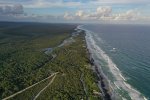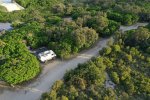Time for a bit of feedback on the modifications and how things went on our latest trip.
With all the drama around snap state border closures, we decided to stay within a few hours drive of the border, so just went down to Black Rock campground in Bundjulung National Park. We were there four years ago just before we started moving around Australia for work, and we liked it a lot, so was an easy choice.

We took a roundabout road to go there, spending a few nights at various other places as it was still school holidays are it was booked out until Australia Day.
We took the "scenic route" which included a few rough washed out tracks, the new shock absorbers worked great, reduced the rolling by a lot. Trish was most impressed and a lot happier. One of the locals suggested a "short cut" up to a campground, which turned out to be a 2 hour extra long drive up some very washed out tracks. Truck did it easy as usual, was just slow and driving straight into the sun most of the time.

We took the normal route on the way down, must quicker and easier.
I noticed that the air intake temperature was a lot higher than normal when we were driving up a long hill. It normally sits around 50-70C, about 30-40C above ambient when on full boost. This time it got over 130C. I pulled over an found the intercooler radiator was leaking. I disconnected the pump and we carried on. I pulled out the radiator for some roadside repairs. It seems when I replaced some of the mounts on the intercooler last week, I manged to tighten the fan so that the shroud pulled into the radiator. We have been traveling on some rough dirt roads and guess the soft aluminium didn't like it.

I repaired it with some JB Weld - the leaking hole was actually quite small, and I sucked a bit of the epoxy into the hole as well.

The fan doesn't come on much, so I will leave it off. Normal driving speed is enough to force the air through the radiators anyway, and I've modified the grill to make sure as much air as possible goes through the radiator. I guess the intercooler really works, given the big drop in intake temperature it creates. This damage also did not stop the truck from working, just meant I have a bit less power and had to watch the EGT on long climbs, it got to 630C before I backed off, and normally it seldom get above 600C on full boost. The JB Weld held water, and we had no problems on the rest of the trip, but simple how just tighten a few bolts too hard on the rubber mounts created a problem. I think I'll replace the radiator anyway.
The new lithium battery system worked great, as did our folding glass auxiliary solar panels which I put up on the roof. We were seeing 20+A going into the battery during the day. Battery new got below 80%, despite having two overcast days. The ability of the lithium batteries to take charge seems so much better than the lead acids, the would be back at 100% in only a few hours of sunshine.

One of the main reasons we loved Black Rock was because of the Jerusalem Creek next door, it is a 9km paddle to the end, and we did it each day we were there. Our inflatable boat works great, however on the very last day as we were packing it up, the floor panel lost air, the seam had come adrift. Looks like an easy repair, and we have all the proper glue etc so will give fixing it a go. We have had the boat for more than 12 years now, and has been used quite a lot.

I also gave the drones a few test flights. The Mavic Pro 2 is just great, super stable with a fantastic camera. I recently bought a Mavic 2 Mini - tiny little drone that weighs 248g. It is super quiet, but no where near as stable in the wind down at the beach. The bigger Mavic is rock solid - does not move at all in the wind, the Mini wanders a bit, so need to be watched carefully, as it can drift a metre or two quite easily. It is a great little drone, and the whole kit can fit in a pocket of a backpack and weighs next to nothing compared to my normal cameras I carry around. I would still take the Mavic Pro over the Mini if I wanted to do an serious photos or videos, but for a bit of fun on a hike or to capture some unique angles, I will carry the Mini with us a lot more.




























